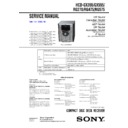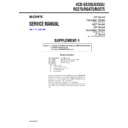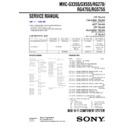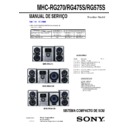Sony HCD-GX355 / HCD-GX555 / HCD-RG270 / HCD-RG475 / HCD-RG575 / MHC-GX355 / MHC-GX555 / MHC-RG270 / MHC-RG475S / MHC-RG575S Service Manual ▷ View online
SERVICE MANUAL
COMPACT DISC DECK RECEIVER
US Model
Canadian Model
HCD-GX355/GX555
AEP Model
UK Model
Australian Model
HCD-RG270/RG475
E Model
HCD-RG270/RG475/RG575
HCD-GX355/GX555/
RG270/RG475/RG575
Ver. 1.4 2005.10
SPECIFICATIONS
9-879-533-05
2005J05-1
© 2005.10
© 2005.10
Sony Corporation
Personal Audio Group
Published by Sony Engineering Corporation
Published by Sony Engineering Corporation
Photo: HCD-RG575
•
HCD-GX355 is the amplifier, CD player, tape
deck and tuner section in MHC-GX355.
deck and tuner section in MHC-GX355.
•
HCD-GX555 is the amplifier, CD player, tape
deck and tuner section in MHC-GX555.
deck and tuner section in MHC-GX555.
•
HCD-RG270 is the amplifier, CD player, tape
deck and tuner section in MHC-RG270.
deck and tuner section in MHC-RG270.
•
HCD-RG475 is the amplifier, CD player, tape
deck and tuner section in MHC-RG475S.
deck and tuner section in MHC-RG475S.
•
HCD-RG575 is the amplifier, CD player, tape
deck and tuner section in MHC-RG575S.
deck and tuner section in MHC-RG575S.
Amplifier section
AUDIO POWER SPECIFICATIONS
(HCD-GX555/GX355 USA model only)
(HCD-GX555/GX355 USA model only)
HCD-GX555
POWER OUTPUT AND TOTAL HARMONIC
DISTORTION:
DISTORTION:
With 6 ohm loads, both channels driven, from
120 – 10,000 Hz: rated 145 watts per channel
minimum RMS power, with no more than 10%
total harmonic distortion from 250 milliwatts to
rated output.
120 – 10,000 Hz: rated 145 watts per channel
minimum RMS power, with no more than 10%
total harmonic distortion from 250 milliwatts to
rated output.
HCD-GX355
POWER OUTPUT AND TOTAL HARMONIC
DISTORTION:
DISTORTION:
With 6 ohm loads, both channels driven, from
120 – 10,000 Hz: rated 150 watts per channel
minimum RMS power, with no more than 10%
total harmonic distortion from 250 milliwatts to
rated output.
120 – 10,000 Hz: rated 150 watts per channel
minimum RMS power, with no more than 10%
total harmonic distortion from 250 milliwatts to
rated output.
North American model:
HCD-GX555
Front speaker
Continuous RMS power output (reference):
Continuous RMS power output (reference):
145 + 145 watts (6 ohms at
1 kHz, 10% THD)
1 kHz, 10% THD)
Tot al harmonic distortion less than 0.07% (6 ohms at
1 kHz, 80 W)
Sub woofer
Continuous RMS power output (reference):
Continuous RMS power output (reference):
170 watts (6 ohms at
80 Hz, 10% THD)
80 Hz, 10% THD)
Tot al harmonic distortion less than 0.07% (6 ohms at
80 Hz, 90 W)
HCD-GX355
Continuous RMS power output (reference):
150 + 150 watts (6 ohms at
1 kHz, 10% THD)
1 kHz, 10% THD)
Tot al harmonic distortion less than 0.07% (6 ohms at
1 kHz, 80 W)
European and Russian models:
HCD -RG475
Front speaker
DIN power output (rated): 110 + 110 watts (6 ohms at
DIN power output (rated): 110 + 110 watts (6 ohms at
1 kHz, DIN)
Continuous RMS power output (reference):
140 + 140 watts (6 ohms at
1 kHz, 10% THD)
1 kHz, 10% THD)
Music power output (reference):
280 + 280 watts (6 ohms at
1 kHz, 10% THD)
1 kHz, 10% THD)
Sub woofer
DIN power output (rated): 130 watts (6 ohms at
DIN power output (rated): 130 watts (6 ohms at
80 Hz, DIN)
Continuous RMS power output (reference):
160 watts (6 ohms at
80 Hz, 10% THD)
80 Hz, 10% THD)
Music power output (reference):
320 watts (6 ohms at
80 Hz, 10% THD)
80 Hz, 10% THD)
– Continued on next page –
Model Name Using Similar Mechanism
NEW
CDM74KFS-F1BD81C (Except Mexican model) or
CD Mechanism Type
CDM74KF-K6BD83S (US, Canadian, AEP, UK, East European,
CD
Russian, E2, E51 models)/CDM74KFS-F1BD84 (Mexican model)
Section
BU-F1BD81C (Except Mexican model) or
Base Unit Name
BU-K6BD83S-WOD (US, Canadian, AEP, UK, East European,
Russian, E2, E51 models)/BU-F1BD84 (Mexican model)
Optical Pick-up Block Name
KSM-215DCP or KSM-213DCP
TAPE
Model Name Using Similar Mechanism
NEW
Section
Tape Transport Mechanism Type
CWM43FF13
•
Abbreviation
E2 : 120V AC Area in E model
E51 : Chilean and Peruvian models
E2 : 120V AC Area in E model
E51 : Chilean and Peruvian models
2
HCD-GX355/GX555/RG270/RG475/RG575
Other models:
HCD-RG5 75
The following measured at AC 120, 127, 220, 240 V
50/60 Hz
Front speaker
DIN power output (rated): 100 + 100 watts (6 ohms at
50/60 Hz
Front speaker
DIN power output (rated): 100 + 100 watts (6 ohms at
1 kHz, DIN)
Continuous RMS power output (reference):
125 + 125 watts (6 ohms at
1 kHz, 10% THD)
1 kHz, 10% THD)
Sub woofer
DIN power output (rated): 120 watts (6 ohms at
DIN power output (rated): 120 watts (6 ohms at
80 Hz, DIN)
Continuous RMS power output (reference):
150 watts (6 ohms at
80 Hz, 10% THD)
80 Hz, 10% THD)
HCD-RG4 75
Front speaker
The following measured at AC 120, 127, 220, 240 V
50/60 Hz
DIN power output (rated): 100 + 100 watts (6 ohms at
The following measured at AC 120, 127, 220, 240 V
50/60 Hz
DIN power output (rated): 100 + 100 watts (6 ohms at
1 kHz, DIN)
Continuous RMS power output (reference):
120 + 120 watts (6 ohms at
1 kHz, 10% THD)
1 kHz, 10% THD)
Sub woofer
DIN power output (rated): 120 watts (6 ohms at
DIN power output (rated): 120 watts (6 ohms at
80 Hz, DIN)
Continuous RMS power output (reference):
150 watts (6 ohms at
80 Hz, 10% THD)
80 Hz, 10% THD)
HCD-RG270
The following measured at AC 120, 127, 220, 240 V
50/60 Hz
DIN power output (rated): 100 + 100 watts (6 ohms at
50/60 Hz
DIN power output (rated): 100 + 100 watts (6 ohms at
1 kHz, DIN)
Continuous RMS power output (reference):
125 + 125 watts (6 ohms at
1 kHz, 10% THD)
1 kHz, 10% THD)
Inputs
AUDIO IN (stereo mini jack):
AUDIO IN (stereo mini jack):
voltage 250 mV,
impedance 47 kilohms
impedance 47 kilohms
MIC (phone jack) (Latin American model only):
sensitivity 1 mV,
impedance 10 kilohms
impedance 10 kilohms
Outputs
PHONES (stereo mini jack):
PHONES (stereo mini jack):
accepts headphones of
8 ohms or more
8 ohms or more
VIDEO OUT (phono jack) (Mexican model only):
max. output level 1Vp-p,
unbalanced, Sync
negative, load impedance
75 ohms
unbalanced, Sync
negative, load impedance
75 ohms
SPEAKER:
accepts impedance of 6 to
16 ohms
16 ohms
SUBWOOFER OUT (HCD-GX555/RG575/
RG475 only):
RG475 only):
accepts impedance of 6 to
16 ohms
16 ohms
CD player section
System
Compact disc and digital
audio system
audio system
Laser Diode Properties
Emission duration:
continuous
Laser Output*:
Less than 44.6
continuous
Laser Output*:
Less than 44.6
µ
W
* This output is the value measurement at a distance of
200mm from the objective lens surface on the
Optical Pick-up Block with 7mm aperture.
Optical Pick-up Block with 7mm aperture.
Frequency response
2 Hz – 20 kHz (
±
0.5 dB)
Signal-to-noise ratio
More than 90 dB
Dynamic range
More than 90 dB
Tape deck section
Recording system
4-track 2-channel, stereo
Frequency response
50 – 13,000 Hz (
±
3 dB),
using Sony TYPE I
cassettes
cassettes
Tuner section
FM stereo, FM/AM superheterodyne tuner
FM tuner section
Tuning range
North American model:
North American model:
87.5 – 108.0 MHz
(100 kHz step)
(100 kHz step)
Other models:
87.5 – 108.0 MHz
(50 kHz step)
(50 kHz step)
Antenna
FM lead antenna
Antenna terminals
75 ohms unbalanced
Intermediate frequency
10.7 MHz
AM tuner section
Tuning range
Pan-American models:
Pan-American models:
530 – 1,710 kHz
(with the tuning interval
set at 10 kHz)
531 – 1,710 kHz
(with the tuning interval
set at 9 kHz)
(with the tuning interval
set at 10 kHz)
531 – 1,710 kHz
(with the tuning interval
set at 9 kHz)
European, Russian and Saudi Arabian models:
531 – 1,602 kHz (with the
tuning interval set at
9 kHz)
tuning interval set at
9 kHz)
Other models:
530 – 1,710 kHz
(with the tuning interval
set at 10 kHz)
531 – 1,602 kHz
(with the tuning interval
set at 9 kHz)
(with the tuning interval
set at 10 kHz)
531 – 1,602 kHz
(with the tuning interval
set at 9 kHz)
Antenna
AM loop antenna
Intermediate frequency
450 kHz
General
Power requirements
North American model:
North American model:
120 V AC, 60 Hz
European and Russian models:
230 V AC, 50/60 Hz
Australian model:
230 – 240 V AC, 50/60 Hz
Argentine model:
220 V AC, 50/60 Hz
Mexican model:
127 V AC, 60 Hz
Saudi Arabian model:
120 – 127, 220 or
230 – 240 V AC, 50/60 Hz
Adjustable with voltage
selector
230 – 240 V AC, 50/60 Hz
Adjustable with voltage
selector
Other models:
120 V, 220 V or
230 – 240 V AC, 50/60 Hz
Adjustable with voltage
selector
230 – 240 V AC, 50/60 Hz
Adjustable with voltage
selector
Power consumption
USA model:
HCD -GX555:
USA model:
HCD -GX555:
285 watts
HCD -GX355:
210 watts
Canadian model:
HCD -GX555:
HCD -GX555:
380 VA
HCD -GX355:
290 VA
European and Russian models:
HCD-RG475:
HCD-RG475:
300 watts
0.25 watts (at the Power
Saving Mode)
0.25 watts (at the Power
Saving Mode)
HCD -RG270:
190 watts
0.25 watts (at the Power
Saving Mode)
0.25 watts (at the Power
Saving Mode)
Other models:
HCD-RG575:
HCD-RG575:
300 watts
HCD-RG475:
300 watts
HCD -RG270:
210 watts
Dimensions (w/h/d) (excl. speakers)
Approx. 280
×
325
430 mm
Mass (excl. speakers)
North American models:
HCD-GX555:
North American models:
HCD-GX555:
Approx. 10.5 kg
HCD-GX355:
Approx. 10.0 kg
Canadian model:
HCD-GX555:
HCD-GX555:
Approx. 10.5 kg
HCD-GX355:
Approx. 10.0 kg
European and Russian models:
HCD-RG475:
HCD-RG475:
Approx. 10.5 kg
HCD-RG270:
Approx. 8.7 kg
Other models:
HCD-RG575:
HCD-RG575:
Approx. 10.5 kg
HCD-RG475:
Approx. 10.5 kg
HCD-RG270:
Approx. 10.0 kg
Design and specifications are subject to change
without notice.
without notice.
HCD -RG270
DIN power output (rated): 80 + 80 watts (6 ohms at
1 kHz, DIN)
Continuous RMS power output (reference):
100 + 100 watts (6 ohms at
1 kHz, 10% THD)
1 kHz, 10% THD)
Music power output (reference):
200 + 200 watts (6 ohms at
1 kHz, 10% THD)
1 kHz, 10% THD)
3
HCD-GX355/GX555/RG270/RG475/RG575
Notes on chip component replacement
• Never reuse a disconnected chip component.
• Notice that the minus side of a tantalum capacitor may be
damaged by heat.
Flexible Circuit Board Repairing
• Keep the temperature of the soldering iron around 270 ˚C
during repairing.
• Do not touch the soldering iron on the same conductor of the
circuit board (within 3 times).
• Be careful not to apply force on the conductor when soldering
or unsoldering.
CAUTION
Use of controls or adjustments or performance of procedures
other than those specified herein may result in hazardous radiation
exposure.
other than those specified herein may result in hazardous radiation
exposure.
UNLEADED SOLDER
Boards requiring use of unleaded solder are printed with the lead-
free mark (LF) indicating the solder contains no lead.
(Caution: Some printed circuit boards may not come printed with
free mark (LF) indicating the solder contains no lead.
(Caution: Some printed circuit boards may not come printed with
the lead free mark due to their particular size)
: LEAD FREE MARK
Unleaded solder has the following characteristics.
• Unleaded solder melts at a temperature about 40 ˚C higher
than ordinary solder.
Ordinary soldering irons can be used but the iron tip has to be
applied to the solder joint for a slightly longer time.
Soldering irons using a temperature regulator should be set to
about 350 ˚C.
Caution: The printed pattern (copper foil) may peel away if
Caution: The printed pattern (copper foil) may peel away if
the heated tip is applied for too long, so be careful!
• Strong viscosity
Unleaded solder is more viscou-s (sticky, less prone to flow)
than ordinary solder so use caution not to let solder bridges
occur such as on IC pins, etc.
occur such as on IC pins, etc.
• Usable with ordinary solder
It is best to use only unleaded solder but unleaded solder may
also be added to ordinary solder.
SAFETY-RELATED COMPONENT WARNING!!
COMPONENTS IDENTIFIED BY MARK
0
OR DOTTED LINE
WITH MARK
0
ON THE SCHEMATIC DIAGRAMS AND IN
THE PARTS LIST ARE CRITICAL TO SAFE OPERATION.
REPLACE THESE COMPONENTS WITH SONY PARTS WHOSE
PART NUMBERS APPEAR AS SHOWN IN THIS MANUAL OR
IN SUPPLEMENTS PUBLISHED BY SONY.
REPLACE THESE COMPONENTS WITH SONY PARTS WHOSE
PART NUMBERS APPEAR AS SHOWN IN THIS MANUAL OR
IN SUPPLEMENTS PUBLISHED BY SONY.
ATTENTION AU COMPOSANT AYANT RAPPORT
À LA SÉCURITÉ!
LES COMPOSANTS IDENTIFIÉS PAR UNE MARQUE
0
SUR
LES DIAGRAMMES SCHÉMATIQUES ET LA LISTE DES
PIÈCES SONT CRITIQUES POUR LA SÉCURITÉ DE
FONCTIONNEMENT. NE REMPLACER CES COM- POSANTS
QUE PAR DES PIÈCES SONY DONT LES NUMÉROS SONT
DONNÉS DANS CE MANUEL OU DANS LES SUPPLÉMENTS
PUBLIÉS PAR SONY.
PIÈCES SONT CRITIQUES POUR LA SÉCURITÉ DE
FONCTIONNEMENT. NE REMPLACER CES COM- POSANTS
QUE PAR DES PIÈCES SONY DONT LES NUMÉROS SONT
DONNÉS DANS CE MANUEL OU DANS LES SUPPLÉMENTS
PUBLIÉS PAR SONY.
SAFETY CHECK-OUT
After correcting the original service problem, perform the following
safety check before releasing the set to the customer:
Check the antenna terminals, metal trim, “metallized” knobs, screws,
and all other exposed metal parts for AC leakage.
Check leakage as described below.
safety check before releasing the set to the customer:
Check the antenna terminals, metal trim, “metallized” knobs, screws,
and all other exposed metal parts for AC leakage.
Check leakage as described below.
LEAKAGE TEST
The AC leakage from any exposed metal part to earth ground and
from all exposed metal parts to any exposed metal part having a
return to chassis, must not exceed 0.5 mA (500 microamperes.).
Leakage current can be measured by any one of three methods.
from all exposed metal parts to any exposed metal part having a
return to chassis, must not exceed 0.5 mA (500 microamperes.).
Leakage current can be measured by any one of three methods.
1. A commercial leakage tester, such as the Simpson 229 or RCA
WT-540A. Follow the manufacturers’ instructions to use these
instruments.
instruments.
2. A battery-operated AC milliammeter. The Data Precision 245
digital multimeter is suitable for this job.
3. Measuring the voltage drop across a resistor by means of a
VOM or battery-operated AC voltmeter. The “limit” indication
is 0.75 V, so analog meters must have an accurate low-voltage
scale. The Simpson 250 and Sanwa SH-63Trd are examples
of a passive VOM that is suitable. Nearly all battery operated
digital multimeters that have a 2 V AC range are suitable. (See
Fig. A)
is 0.75 V, so analog meters must have an accurate low-voltage
scale. The Simpson 250 and Sanwa SH-63Trd are examples
of a passive VOM that is suitable. Nearly all battery operated
digital multimeters that have a 2 V AC range are suitable. (See
Fig. A)
Fig. A.
Using an AC voltmeter to check AC leakage.
1.5 k
Ω
0.15
µ
F
AC
voltmeter
(0.75 V)
voltmeter
(0.75 V)
To Exposed Metal
Parts on Set
Parts on Set
Earth Ground
This appliance is classified as
a CLASS 1 LASER product.
This marking is located on the
rear exterior.
a CLASS 1 LASER product.
This marking is located on the
rear exterior.
4
HCD-GX355/GX555/RG270/RG475/RG575
TABLE OF CONTENTS
1.
SERVICING NOTES
...............................................
5
2.
GENERAL
...................................................................
6
3.
DISASSEMBLY
3-1.
Disassembly Flow ...........................................................
8
3-2.
Case (Top) .......................................................................
9
3-3.
Door (CD) ........................................................................
9
3-4.
Front Panel Section ......................................................... 10
3-5
Mechanical Deck (CWM43FF13) ................................... 10
3-6.
CD Mechanism Deck (CDM74KFS-F1BD81C (Except
MX model)/CDM74KFS-F1BD84 (MX model)) ........... 11
MX model)/CDM74KFS-F1BD84 (MX model)) ........... 11
3-7.
Back Panel Section .......................................................... 11
3-8.
MAIN Board .................................................................... 12
3-9.
BD Board/CD Board ....................................................... 12
3-10. DRIVER Board, SW Board ............................................. 13
3-11. Optical Pick-up Block (KSM-215DCP) .......................... 13
3-12. SENSOR Board ............................................................... 14
3-13. MOTOR (TB) Board ....................................................... 14
3-14. MOTOR (LD) Board ....................................................... 15
3-11. Optical Pick-up Block (KSM-215DCP) .......................... 13
3-12. SENSOR Board ............................................................... 14
3-13. MOTOR (TB) Board ....................................................... 14
3-14. MOTOR (LD) Board ....................................................... 15
4.
TEST MODE
.............................................................. 16
5.
ELECTRICAL ADJUSTMENT
............................ 20
6.
DIAGRAMS
6-1.
Block Diagram – CD SERVO Section – ........................ 21
6-2.
Block Diagram – AUDIO/VIDEO Section – ................. 22
6-3.
Block Diagram – AMP Section – ................................... 23
6-4.
Block Diagram
– PANEL, POWER SUPPLY Section – .......................... 24
– PANEL, POWER SUPPLY Section – .......................... 24
6-5.
Printed Wiring Board
– CD Board – (Except MX model) ................................. 26
– CD Board – (Except MX model) ................................. 26
6-6.
Schematic Diagram
– CD Board – (Except MX model) ................................. 27
– CD Board – (Except MX model) ................................. 27
6-7.
Printed Wiring Board – BD Board – (MX model) ......... 28
6-8.
Schematic Diagram – BD Board – (MX model) ............ 29
6-9.
Printed Wiring Boards – CHANGER Section – ............. 30
6-10. Schemtic Diagram – CHANGER Setion – ..................... 31
6-11. Printed Wiring Board – MAIN Board – ......................... 32
6-12. Schematic Diagram – MAIN Board (1/3) – ................... 33
6-13. Schematic Diagram – MAIN Board (2/3) – ................... 34
6-14. Schematic Diagram – MAIN Board (3/3) – ................... 35
6-15. Printed Wiring Board – POWER Board – ...................... 36
6-16. Schematic Diagram –POWER Board – .......................... 37
6-17. Printed Wiring Board – SUB WOOFER Board –
6-11. Printed Wiring Board – MAIN Board – ......................... 32
6-12. Schematic Diagram – MAIN Board (1/3) – ................... 33
6-13. Schematic Diagram – MAIN Board (2/3) – ................... 34
6-14. Schematic Diagram – MAIN Board (3/3) – ................... 35
6-15. Printed Wiring Board – POWER Board – ...................... 36
6-16. Schematic Diagram –POWER Board – .......................... 37
6-17. Printed Wiring Board – SUB WOOFER Board –
(GX555/RG475/RG575 only) ......................................... 38
6-18. Schematic Diagram – SUB WOOFER Board –
(GX555/RG475/RG575 only) ......................................... 39
6-19. Printed Wiring Boards
– AUDIO, MIC, HEADPHONE Boards – ...................... 40
6-20. Schematic Diagram
– AUDIO, MIC, HEADPHONE Boards – ...................... 41
6-21. Printed Wiring Boards – CD-G Section –
(MX model only) ............................................................. 42
6-22. Schematic Diagram – CD-G Section –
(MX model only) ............................................................. 43
6-23. Printed Wiring Board – PANEL Section (1/2) ............... 44
6-24. Printed Wiring Board – PANEL Section (2/2) ............... 45
6-25. Schematic Diagram – PANEL Section (1/2) .................. 46
6-26. Schematic Diagram – PANEL Section (2/2) .................. 47
6-27. Printed Wiring Boards – TRANS Section – ................... 48
6-28. Schematic Diagram – TRANS Section – ....................... 49
6-24. Printed Wiring Board – PANEL Section (2/2) ............... 45
6-25. Schematic Diagram – PANEL Section (1/2) .................. 46
6-26. Schematic Diagram – PANEL Section (2/2) .................. 47
6-27. Printed Wiring Boards – TRANS Section – ................... 48
6-28. Schematic Diagram – TRANS Section – ....................... 49
7.
EXPLODED VIEWS
7-1.
Overall Section ................................................................ 66
7-2.
Back Panel Section .......................................................... 67
7-3.
Front Panel Section ......................................................... 68
7-4.
Key Section ..................................................................... 69
7-5.
Chassis Section ................................................................ 70
7-6.
Transformer Section ........................................................ 71
7-7.
CD Mechanism Deck Section-1
(CDM74KFS-F1BD81C) (Except MX model)/
(CDM74KFS-F1BD84) (MX model) .............................. 72
(CDM74KFS-F1BD81C) (Except MX model)/
(CDM74KFS-F1BD84) (MX model) .............................. 72
7-8.
CD Mechanism Deck Section-2
(CDM74KFS-F1BD81C) (Except MX model)/
(CDM74KFS-F1BD84) (MX model) .............................. 73
(CDM74KFS-F1BD81C) (Except MX model)/
(CDM74KFS-F1BD84) (MX model) .............................. 73
8.
ELECTRICAL PARTS LIST
................................ 74
•
Abbreviation
MX: Mexican model
MX: Mexican model
Ver. 1.1




